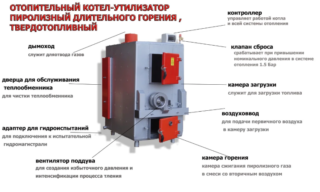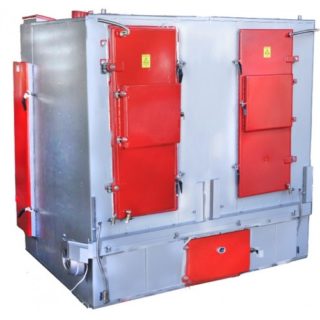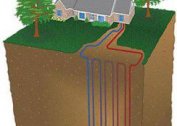During the operation of certain types of industrial plants, large volumes of exhaust gases with a very high temperature are emitted, polluting the environment. In order to use these substances to the benefit of production and minimize the burden on the environmental situation, a waste heat boiler was invented.
Description of the types of waste-heat boilers
The work of heat exchange units is based on the transfer of energy available in hot gas masses to a liquid coolant. A recovery boiler is usually not equipped with a burner, since its design does not imply heating and burning of fuel resources. But an incandescent electrode and a unit are mounted in it, which provides artificial movement of gas along the internal paths of the boiler unit. Devices differ in a number of characteristics: they are single and double-circuit, with different dimensions of the heating tank.
Depending on the temperature of the exhaust gases, the units can be divided into those operating with low and high temperatures. Indicators up to 900 ° C fall into the first category, exceeding 1000 ° C into the second category.
According to the principle of operation, waste heat boilers can be divided into two classes. Steam units are used to generate hot steam for heating or industrial use. Water heaters receive gases that leave the unit and transfer their heat to water. The latter can be used for heating or other purposes.
Steam devices and boilers designed to heat water can be equipped with a combustion chamber. Since during the recycling of the masses of gases that would otherwise enter the atmosphere, a lot of energy is generated, such boilers are sometimes used to produce electricity. There are models that are not equipped with a firebox. In such devices, gases directly act on the heat exchanger with liquid or steam.
All structural elements in which combustion processes occur are made of fire-resistant materials.
Equipment
 In the basic configuration, the boiler units are equipped with a sufficient number of functional blocks. It necessarily includes a pump group, insulation devices, control panel.
In the basic configuration, the boiler units are equipped with a sufficient number of functional blocks. It necessarily includes a pump group, insulation devices, control panel.
The reorientation of a manufacturing enterprise or the development of new areas of activity by it may necessitate additional technical devices. It may include such elements:
- protective devices: heat-resistant shielding, safety blocks, shut-off valves, suspension parts;
- pump equipment;
- devices providing ventilation and air mass injection.
In some multicomponent systems, reinforcing elements from the plumbing arsenal are also used. They are needed for the construction of various types of heat exchangers.
In some situations, it is advisable to purchase a source of uninterrupted electricity. The design of a number of models provides the ability to connect a burner.
Specifications
The use of gas waste in full allows boilers to have high efficiency indicators. For devices operating on liquid or solid fuel, they are significantly smaller. However, if the heat transfer surfaces are very clogged, the efficiency of the unit is reduced. These parts of the structure can be cleaned by washing with water or blowing with steam. The technology of vibration cleaning is also practiced.
Different types of boilers are involved in various industries at certain stages of the production cycle. They differ in the number of vaporization registers, power parameters used by circulating circuits, exactingness to the quality of the coolant.
How efficiently the unit will work depends on the type of supply, the amount of gas masses and their temperature. The amount of waste emitted varies by industry. The greatest amount is formed during oil refining and in metallurgy. Batch gas is specific to the latter. The presence of metal scale is favorable for burning gas fuel.
Advantages and disadvantages
From other types of boiler units, the considered devices are distinguished by the absence of the need for additional fuel. The utilizer operates only on gas waste. This allows you to use fuel much more efficiently, as well as reduce the cost of cleaning the exhaust. In addition, the use of such boilers in enterprises has a positive effect on the environment. Energy emissions are significantly reduced. Due to the reduction in the volume of combustible fuel containing hydrocarbons, significantly less greenhouse gases enter the atmosphere. An energy-efficient production cycle reduces enterprise costs.
Cold parts are corroded. The efficiency of utilization of the utilizer depends on the temperature to which the produced gases are heated.
Features of work
During the operation of the boiler, its heat exchanger is covered with substances contained in the flue gases. This does not affect the efficiency of the utilizer in the best way. To make the efficiency as high as possible, you can install a thermo-oxidizer of volatile organic matter in front of it.
If the need to use the heat of exhaust gases arises only from time to time, it is possible to regulate the flow of emissions to the boiler. For this, a special bypass is used - a unit that redirects waste to the chimney. The bypass function can be controlled by means of a dry contact, which assumes an open and blocked state, or using an external analog signal. In the latter case, the process is tied to regulating the opening angle of the shutter.
Application area
It is advisable to install waste heaters if as a result of some process a lot of physical heat is released, which should be further used to reduce fuel consumption. This includes quenching of coke and the operation of gas turbines. In the latter case, the boiler is used to generate steam, which subsequently goes to the heating of the enterprise or the solution of technological problems.
There are also modifications of the convective type, sharpened by the task of cooling carbon gases. They are used for melting steel. The design features of these units provide a large number of cycles of artificial circulation and two-stage evaporation. Some boilers include carbon monoxide burning. Cooling converter waste reduces ablation and air pollution.
At thermal power plants, advanced variations of utilizers are used. For the preparation of water, a heating heating system and hot water supply, atmospheric pressure deaeration devices are used. They are also involved in the preparation of the coolant for steam boilers. For vacuum deaeration, secondary gas masses are emitted during the operation of the turbine. The result is steam that is subsequently reused in the turbine unit. This saves fuel resources. Often the steam generated has high pressure.
The use of utilizers in the production cycle brings a number of useful effects: fuel is consumed more rationally, the input of thermal energy and harmful compounds into the external environment is significantly reduced. When working with gases of sufficient temperature, the units have a very high efficiency.





